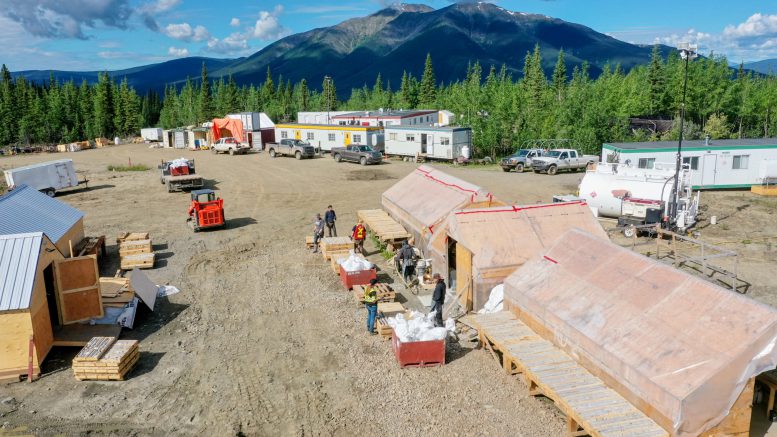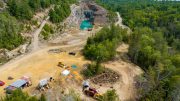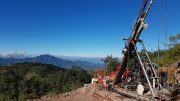Canada is one of the best-endowed countries on Earth when it comes to minerals and has the skilled workforce needed to extract them. Here’s a look at eight companies active across British Columbia, the Prairie provinces and the Far North looking for precious, base and energy metals.
Ascot Resources
In April Ascot Resources (TSX: AOT; US-OTC: AOTVF) poured first gold as part of the commissioning process at its Premier gold project in the Golden Triangle of northwestern British Columbia.
The first gold pour from the project, 25 km north of the town of Stewart on Nisga’a Nation treaty lands, was from gold recovered through the gravity circuit. Commissioning of the carbon-in-leach (CIL) circuit is underway. The company expects commercial production to begin before the end of the third quarter.
The most recent estimate in May pegged capital costs at $339 million, up from less than $150 million forecast in a 2020 feasibility study.

A tunnel at Ascot Resources’ Big Missouri operation. Credit: Ascot Resources
The project consists of four underground operations (Silver Coin, Big Missouri, Premier and Red Mountain) feeding a centralized 2,500-tonne-per-day processing facility. The project is expected to produce a total about 1.1 million oz. gold and 3 million oz. silver over eight years . Mining will start from the Silver Coin and Big Missouri deposits, followed by the Red Mountain deposit in year three and then the Premier deposit.
Access for production will be through new and existing adits (side hill portal access). Mining methods will include low-cost long hole stoping for most of the mineralized material, with limited use of inclined undercut long hole, room and pillar, and cut-and-fill mining methods in select shallow or flat lying slopes. The company closed a US$50-million financing from Sprott Resource Streaming and Royalty and its affiliates and Nebari Natural Resources Credit Fund II LP on Feb. 20.
Ascot Resources has a market cap of approximately $481 million.
Banyan Gold
Banyan Gold (TSXV: BYN; US-OTC: BYAGF) is focused on two advanced gold projects in the Yukon: AurMac and Hyland.
The AurMac gold project, formerly known as the Aurex-McQuesten project, consists of two near/on-surface deposits (Powerline and Airstrip) in the Mayo Mining District, about 56 km northeast of the village of Mayo and 356 km north of Whitehorse.
In February, the company updated the project’s resource. It now hosts pit-constrained inferred resources of 7 million oz. gold in 347.5 million tonnes grading 0.63 gram gold per tonne. The estimate used a cut-off grade of 0.3 gram gold and the majority of the gold (6.2 million oz.) is contained within the Powerline deposit.
Banyan plans to drill 5,000 metres at AurMac this summer, using two drill rigs. The campaign began on June 3.
Metallurgical studies have demonstrated that the mineralization at Powerline is amenable to conventional mining processes including carbon-in-pulp (CIP), carbon-in-leach (CIL) and heap leaching.
The 173-sq.-km project sits 30 km from Victoria Gold’s (TSX: VGCX) Eagle project and next to Hecla Mining’s (NYSE: HL) Keno Hill silver mine. Banyan has the right to earn up to a 100% interest in both the Aurex and McQuesten properties, subject to certain royalties.
Banyan’s 100%-owned Hyland project, 70 km northeast of Watson Lake, lies along the southeast end of the Tintina Gold Belt.
Hyland hosts 8.6 million indicated tonnes grading 0.78 gram gold and 7.04 grams silver (0.85 gram gold equivalent per tonne) for 236,000 gold equivalent oz. and another 10.8 million inferred tonnes grading 0.77 gram gold and 5.32 grams silver (0.83 gram gold equivalent) for 288,000 gold equivalent ounces. The resource used a cut-off grade of 0.3 gram gold equivalent.
Banyan Gold has a market cap of about $89 million.
Callinex Mines
Callinex Mines’ (TSX: CNX; US-OTC: CLLXF) flagship project is Pine Bay in Manitoba, about 16 km from HudBay Minerals’ (TSX: HBM; NYSE: HBM) Flin Flon processing facilities.
The company has completed more than 10,000 metres of drilling since 2014 and the 120-sq.-km property contains numerous stacked horizons hosting seven deposits, including Pine Bay, Rainbow, Alchemist, Cabin and Baker Patton.
Highlights from Rainbow include 37 metres of 6% copper, including 1 metre of 18.81% copper in hole PBM-138; 67 metres of 2.73% copper including 13 metres of 8.75% copper in hole PBM-129-W2; and 4.9 metres of 14.94% copper including 2.8 metres of 21% copper in PBM-129-W1. All three highlight holes were drilled in 2021.

Talisker Resources’ Bralorne site in British Columbia. Credit: Talisker Resources
Rainbow hosts indicated resources of 3.4 million tonnes grading 3.14% copper, 0.34 gram gold per tonne, 0.75% zinc, 6.26 grams silver and 0.03% lead (3.59% copper equivalent). Inferred resources come to 1.3 million tonnes grading 2.55% copper, 0.27 gram gold, 0.69% zinc, 5.39 grams silver, and 0.03% lead (2.95% copper equivalent). The resource used a 1.3% copper-equivalent cut-off grade.
Using the same cut-off grade, the Pine Bay deposit hosts 1 million inferred tonnes grading 2.62% copper for 58.1 million lb. contained copper.
On May 28, the company announced it received a $250,000 grant from the Manitoba Mineral Development Fund to advance the Pine Bay project. The funds will be used to pay for long lead items to support permitting and future mine development. Since 2020, Callinex has received more than $1 million in grants from the provincial fund to advance copper discoveries at the project.
In New Brunswick, Callinex is exploring the Nash Creek project, about 25 km from the Brunswick Smelter. A 2018 preliminary economic assessment outlined a 10-year, 3,900 tonne-per-day open pit mining operation that would produce 77 million lb. of zinc, 15 million lb. of lead, and 437,000 oz. of silver annually. The capex was pegged at $168 million.
Nash Creek contains indicated resources of 963 million lb. zinc-equivalent within 13.6 million tonnes grading 3.2% zinc-equivalent (2.7% zinc, 0.6% lead and 17.8 grams silver per tonne). Inferred resources total 5.9 million tonnes grading 3.1% zinc-equivalent (2.7% zinc, 0.5% lead and 14 grams silver) for 407 million lb. zinc-equivalent.
In Newfoundland, the company also holds the Pt. Leamington volcanogenic massive sulphide project.
Callinex Mines has a market cap of roughly $28 million.
EMP Metals
Lithium explorer EMP Metals (CSE: EMPS; US-OTC: EMPPF) holds 793 sq. km of subsurface dispositions and well bores in Saskatchewan in a 75%-25% partnership with ROK Resources (TSXV: ROK; US-OTC: ROKRF), an oil and gas company.
In January, EMP reported results from a preliminary economic assessment (PEA) of the Viewfield lithium brine project. The PEA encompasses about 110 sq. km on the Duperow formation, near Stoughton, in southeastern Saskatchewan.
The study outlined a direct lithium extraction (DLE) project life of 23 years producing a total of 282,090 tonnes of lithium carbonate equivalent (LCE) for an average rate of 12,175 tonnes LCE per year. With average all-in operating costs of US$40 million per tonne LCE a year, the project’s US$571-million capital cost could be paid back in 2.4 years, after taxes.
The project has a post-tax net present value (at an 8% discount rate) of US$1.1 billion and an internal rate of return of 45%. The PEA was based on a constant price of US$20,000 per tonne LCE.
Using a hub and spoke model, the study envisioned five DLE sites and two sites for concentration, refining and conversion (CRC) that would process an average of 62,000 cubic metres of brine per day. The DLE facilities would first concentrate the product into a lithium chloride solution that would be pumped to the CRC locations and refined into battery-grade LCE.
At the end of last year, EMP and its subsidiary, Hub City Lithium Corp., completed a large-scale pilot that processed 87,000 litres of brine from Viewfield. Under the pilot, 8,300 litres of concentrated eluent with an average lithium concentration of 1,430 mg per litre were recovered. Average lithium recoveries were greater than 90%, with an impurity rejection rate of 99.62%.
In April, EMP announced it had begun commissioning a DLE field pilot facility in Estevan, Sask. The facility is the first Koch Technology Solutions DLE pilot skid to be commissioned and operated in Canada.
EMP Metals has a market cap of roughly $35 million.
Fortune Minerals
Fortune Minerals (TSX: FT) has spent about $137 million to advance its NICO cobalt-gold-bismuth copper deposit from discovery in 1996 to development. It plans to update the project’s 2014 feasibility study this year. NICO, which lies about 160 km north of Yellowknife, already has environmental assessment approval as well as major mine permits in hand.
Fortune envisions an open pit and underground mine and concentrator in the Northwest Territories and a related hydrometallurgical refinery in Alberta. That facility would process concentrates from NICO and other materials to produce cobalt sulphate, gold doré, bismuth ingots and copper.
In May, Fortune received funding from both the Canadian government and the United States Department of Defense (DoD) to advance NICO. The federal government will provide up to $7.5 million to support 75% of the cost of additional engineering and test work, through its Global Partnerships Initiative, while the U.S. DoD has awarded a US$6.4-million grant under the Defense Production Act to expand the domestic capacity and production of cobalt for battery and high strength alloy supply chains. Fortune says the funds will allow it to advance NICO to a construction decision.
Last year, the company announced a collaboration with Rio Tinto (ASX: RIO; NYSE: RIO; LSE: RIO) to assess the feasibility of blending intermediate products produced from Kennecott smelter wastes in Utah with process streams from NICO to augment cobalt and bismuth production.
The iron-oxide-copper gold deposit has combined underground and open-pit proven and probable mineral reserves of about 33 million tonnes grading 1.03 grams gold, 0.11% cobalt, 0.14% bismuth and 0.04% copper for contained metal of 1.1 million oz. gold, 82.3 million lb. cobalt, 102.1 million lb. bismuth and 27.2 million lb. copper.
Fortune’s nearby Sue-Dianne copper-silver-gold deposit, about 24 km from NICO, could provide a potential source of incremental mill feed to extend the life of the NICO concentrator. The IOCG deposit has 8.4 million indicated tonnes grading 0.8% copper, 3.2 grams silver per tonne and 0.07 gram gold. Inferred resources add 1.6 million tonnes of 0.79% copper, 2.4 grams silver and 0.07 gram gold.
Fortune Minerals has a market cap of about $43 million.
Quartz Mountain Resources
In April, Quartz Mountain Resources (TSXV: QZM; US-OTC: QZMRF) announced a new discovery at its Maestro gold-silver-copper-molybdenum project, 50 km south of Smithers.
Drill results at the Prodigy epithermal target returned 102 metres grading 2.22 grams gold and 104 grams silver per tonne (3.49 grams gold-equivalent per tonne) starting from 537 metres downhole in hole PR-23-02. The interval included 12 metres of 1.23 grams gold and 586 grams silver (8.01 grams gold-equivalent) and 36 metres of 5.73 grams gold and 87 grams silver (6.69 grams gold-equivalent).
The company says the results represent the discovery of a substantial gold-silver system at the 23.1-sq.-km Maestro project, and could be related to the Lone Pine molybdenum-copper porphyry deposit about 1 km south of Prodigy.
Previous owners of Lone Pine drilled about 24,300 metres in 49 holes. The deposit hosts historic resources of 110 million measured and indicated tonnes grading 0.083% molybdenum and 25.8 million inferred tonnes grading 0.09% molybdenum at a 0.04% molybdenum cut-off grade.
Exploration at Maestro dates to 1914 and was focused on base metal porphyry mineralization, Quartz Mountain says, but the potential for precious metals in the surrounding area was largely unexplored.
The company’s second project in British Columbia is the Jake porphyry copper-gold-silver project, 160 km north of Smithers.
Mineralization at Jake is contained within a prominent gossan measuring 3.5 km long by 1.5 km wide over an elevation of more than 800 metres. The target area contains a swarm of Babine age monzonite dykes intruding sedimentary rocks that host areas of alteration and mineralization. The company plans to drill the project this year.
An IP survey in 2022 indicated the presence of an extensive sulphide mineral system underlying an area of highly anomalous copper, gold, silver and molybdenum values in soils.
Quartz Mountain Resources is associated with the Hunter Dickinson group and has a market cap of about $26.4 million.
Rackla Metals
Rackla Metals (TSXV: RAK) has projects in the eastern Yukon and western Northwest Territories and is focused on exploring the eastern Tombstone Gold Belt for reduced intrusion-related gold system (RIRGS) deposits.
Exploration last year at the company’s Astro Plutonic Complex, which consists of the Keele Pluton, the Kelvin Stock, the Canol Trail Stock, and the Border Pluton targets, resulted in the HIT discovery at Canol Trail Stock, and the Peak and Cirque discoveries at Kelvin Stock.
Rackla began its 2024 field season in June with drilling planned at HIT, and an initial drill program at Peak. The company also plans to advance the Cirque target to a drill-ready stage and explore its other projects in the belt.
Rackla’s work at the Astro Plutonic Complex, which lies within the eastern Selwyn Basin and western Misty Creek Embankment, has included an airborne geophysical survey, stream sediment, soil (talus-fine) and rock sampling, prospecting and mapping.
In 2023, the company collected 314 talus-fine samples in the southeastern portion of the Kelvin Stock and defined two anomalous areas: Peak and Cirque. The Peak anomaly measures 1.5 km by 1 km and has coincident gold, arsenic and bismuth values. About 20% of rock samples (49 out of 237 samples) returned greater than 1 gram gold with the highest value grading 17.8 grams gold. The gold occurs primarily in sheeted quartz-arsenopyrite-bismuth veins that occur in the sedimentary rocks along the eastern margin of the Kelvin Stock.
The Cirque target also has coincident gold, arsenic and bismuth values. The company plans a surface program and then drill testing later in the 2024 season.
Last year, the company drilled 1,000 metres in five holes at Canol Trail Stock’s HIT target, about 10 km north of Kelvin Stock. Hole HIT-003 cut 16.5 metres of 0.67 gram gold and hole HIT-004 cut 45.5 metres of 0.52 gram gold.
The company has several other projects across the Yukon and Northwest Territories including the intrusion-hosted gold targets Black, Fan, Jos and Rak Main; and Gossan, a porphyry copper-gold project.
Rackla Metals has a market cap of about $11.8 million.
Talisker Resources
Talisker Resources (TSX: TSK; US-OTC: TSKFF) is focused on reviving the past-producing Bralorne gold project in British Columbia.
Three historic mines at Bralorne — Bralorne, Pioneer and King — produced a total of 4.2 million oz. gold at an average recovered grade of 17.7 grams gold per tonne. Production ended in 1971 due to low gold prices. Of the 63 veins identified, 30 were mined, 29 of them to a maximum depth of 900 metres. One vein, the 77T, was mined continually to 1.9 km, and all the veins remain open at depth.
This year Talisker has signed ore purchase and processing agreements with New Gold (TSX: NGD) to treat 350,000 tonnes of material at its New Afton mill. It also signed a deal to process 6,300 tonnes of stockpile at Nicola Mining’s (TSXV: NIM; US-OTC: HUSIF) Craigmont mill. The company has not released an economic study for the project, but it plans to start test mining this year using long-hole stoping.
Talisker outlined an indicated resource at Bralorne last year totalling 117,000 tonnes grading 8.9 grams gold for 33,000 oz. contained gold. It hosts 8 million tonnes grading 6.3 grams gold for 1.6 million gold ounces is in the inferred category. The resource was defined along a strike length of 4.5 km and to a depth of 700 metres, and it remains open along strike and at depth.
Highlights from its recent resource conversion drill program include 56.88 grams gold over 1 metre in drillhole SB-2024-018 and 11.74 grams gold over 2.1 metres within a broader intercept of 3.31 grams gold over 11 metres in the BK-9870 Vein. Hole SB-2024-007 intersected 8.81 grams gold over 4.1 metres within a broader 17.7-metre interval of 3.34 grams gold in the BK-9870 Vein.
In addition to Bralorne, Talisker owns the Ladner gold project with exploration potential from an historic mine, and the Spences Bridge greenfields project, where the company holds about 85% of the emerging Spences Bridge Gold Belt, and other early stage greenfields projects.
The 144-sq.-km Ladner gold project, 150 km east of Vancouver and 18 km from the town of Hope, contains five historic mines and 24 known gold occurrences. Of 175 rock samples taken last year, 137 samples (78.3%) were anomalous for gold; 88 samples (50.3%) yielded above 0.1 gram gold; 40 samples (22.8%) yielded above 0.5 gram gold and 24 samples (13.7%) returned more than 1.50 grams gold.
At the 2030-sq.-km Spences project, a geochemical program has identified more than 100 anomalies. Over 9,000 soil samples have been collected validating five prospects as drill ready targets.
Talisker Resources has a market cap of around $45 million.






Be the first to comment on "Snapshot: Eight companies advancing projects in BC, the Prairies and the Far North"